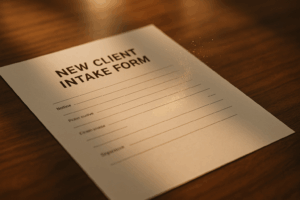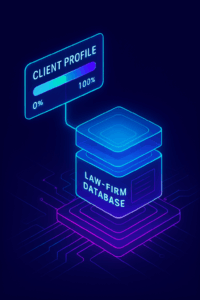FIRST IMPRESSIONS, LASTING CASES

Why the smartest U.S. law firms treat those first blank lines like gold dust—and how you can, too.
The 90‑Second Snapshot
Picture this: a would‑be client, smartphone in hand, taps open your “Request a Consultation” page. They’re in a grocery‑store parking lot, adrenaline high, thumb hovering. You have 90 seconds—maybe less—before distraction or doubt vaporizes the lead. Ask the right questions and you’ll capture a fully‑qualified matter that feeds straight into your case‑management stack. Ask the wrong ones (or too many) and you’ll join the 70 percent of forms that get abandoned mid‑stream.³
Capturing essential client information early isn’t clerical housekeeping; it’s the hinge on which trust, compliance, and revenue all swing. Below is your field guide, WIRED‑style, to getting those questions—and answers—exactly right.
1 Why Early Data Matters
-
Conflict checks in real time. With the client’s full legal name and opposing‑party info, your software can screen conflicts before you waste billable minutes on a doomed consult.¹
-
Hyper‑targeted consults. When the form captures goals, deadlines, and matter type, lawyers walk into the first meeting pre‑armed with strategy, not small talk.²
-
Marketing intelligence. Source‑tracking fields (“How did you find us?”) fuel the ROI dashboards that decide next quarter’s ad spend.¹
In short, quality data gives you speed, insight, and—crucially—ethical cover.
 2 The Goldilocks Principle of Forms
2 The Goldilocks Principle of Forms
| Number of Required Fields | Average Completion Rate |
|---|---|
| 4 or fewer | 87 % |
| 5‑10 | 71 % |
| 11‑15 | 54 % |
| 16+ | Crash & burn (≤ 35 %) |
Table 1 – Form‑abandonment risk climbs as field count grows (compiled from cross‑industry studies).³
The lesson? Collect only what you need to move the matter forward—nothing more, nothing later.
3 Universal Essentials
Most practice areas agree on a minimalist core:
| Field | Why You Need It |
|---|---|
| Legal Name (First, Middle, Last) | Conflict search + pleading accuracy |
| Cell & Email | Multi‑channel follow‑up; SMS preferred by 89 % of consumers |
| Zip Code / Jurisdiction | Venue check; avoids wasted consults |
| Opposing Party (if known) | Immediate conflict screen |
| Matter Type Selector | Routes to correct practice group & template set |
| “How Did You Hear About Us?” | Marketing attribution |
Capture these six and you’ve earned the right to ask more—later.
4 Practice‑Specific Add‑Ons
| Practice | Must‑Have Early Fields | Red‑Flag Questions to Delay |
|---|---|---|
| Personal Injury | Date of incident; injury type | Full medical records (ask post‑retainer) |
| Family Law | Marriage date; children Y/N | Detailed financial affidavits |
| Immigration | Current status; visa expiry | Employer tax docs |
| Estate Planning | Age bracket; marital status | Total net‑worth statements |
Table 2 – Tailor your first‑pass data to decision‑point facts, not discovery‑level detail.
BLOCK QUOTE
“A good intake form collects the decision data—enough to know if you can help—then gets out of the client’s way.”
—Catherine Brock, legal‑tech writer²
5 UX Tricks that Triple Completion
-
Progress bars. Show “Step 1 of 3” so clients know the pain is finite.
-
Conditional logic. If a caller says the spouse already has counsel, then reveal the extra fields—otherwise stay invisible.²
-
Mobile‑first layout. Thumbs, not keyboards. Think big buttons, auto‑capitalization, numeric pads for phone fields.¹
-
Inline validation. Catch typos in email addresses instantly, not after “Submit.”⁵
-
Save & resume. Life happens; don’t punish users for incoming calls.³
These tweaks alone can lift form completion by 20‑plus percentage points, according to SaaS benchmarks.³
 6 Security & Ethics Out of the Gate
6 Security & Ethics Out of the Gate
Early data capture also triggers early responsibility:
-
Encrypted transit & storage. Plain‑text emails are malpractice waiting to happen. Use client portals or at least SSL‑secure forms.⁶
-
Privacy notice in plain English. Data scandals have made clients skittish; spell out where info goes.³
-
No “free advice” traps. Train intake staff and chatbots to clarify they are not yet providing legal counsel—protecting Model Rule 1.18 duties.¹
7 Tools of the Trade
| Tool | Strength | Killer Early‑Data Feature |
|---|---|---|
| Clio Grow | All‑in‑one CRM + intake | Auto‑creates contact on form submit; zero re‑typing¹ |
| MyCase Intake Forms | End‑to‑end PM integration | Drag‑and‑drop builder with conditional logic² |
| Lawmatics | Marketing‑heavy firms | Progressive profiling—asks only what’s needed today⁶ |
| Cognito Forms | Budget‑friendly DIY | HIPAA‑grade encryption & save‑resume links⁵ |
Pick one that talks to your case‑management backbone; “enter once, reuse forever” is the mantra.
8 Futurecast: AI‑Driven Smart Forms
-
Generative AI will soon draft follow‑up questions in real time as the client types, cutting form length by up to 40 %.
-
Sentiment analysis flags frustrated users, triggering live‑chat rescue.
-
Automatic ID verification (selfie + driver’s license) bakes KYC into onboarding without an extra email.
Early adopters already report double‑digit gains in conversion—and a steep drop in “ghost” leads that never show to consult.
ESSENTIALS CHECKLIST
-
Client legal name
-
Primary phone (SMS‑enabled)
-
Email address
-
Zip / jurisdiction
-
Matter type selector
-
Opposing party (if any)
-
Event date / urgency flag
-
Preferred contact method
-
Referral source
-
Checkbox consent + privacy notice
Print it, tape it to every monitor—then watch your abort rate shrink.
Visual Case Brief
Client: Jane D.
Issue: Rear‑end collision, 6/8/25
Essential Data Captured (45 secs):
– Name, cell, email
– Incident date & location
– Other driver insured by GEICO
– Found firm via Google LSA
Outcome: Conflict cleared, consult booked, retainer e‑signed within 2 hrs.
The Take‑Home
Capturing essential client information early isn’t busywork—it’s the linchpin of modern legal intake. Nail the what, when, and how of those first six questions and you’ll accelerate conflict checks, personalize consults, slash admin costs, and close more of the clients you actually want. Miss the moment and you’ll never know how many high‑value matters scrolled past your form—unfinished, unanswered, and unrecoverable.
Endnotes
-
Clio, “Client Intake Best Practices for Law Firms in 2025.” Clio
-
MyCase, “Legal Client Intake: The Ultimate Guide for Law Firms.” MyCase
-
Content Snare, “Form Abandonment: What Is It and How to Avoid It?” Content Snare
-
GrowLaw, “Best Client Intake Practices for Law Firms.” Grow Law
-
Cognito Forms, “Intake Form Best Practices.” Cognito Forms
-
Lawmatics, “What Should Be on a Client Intake Form?” Lawmatics
-
RunSensible, “Essentials of a Client Intake Form.” RunSensible
-
Birdview PSA, “Client Onboarding Best Practices, Checklist & Strategies.” Birdview PSA
-
Deliberate Directions, “Proven Techniques to Improve Client Onboarding at Law Firms.” Deliberate Directions
-
The Freelance Firm, “How to Streamline Client Intake Processes.” thefreelancefirm.com

